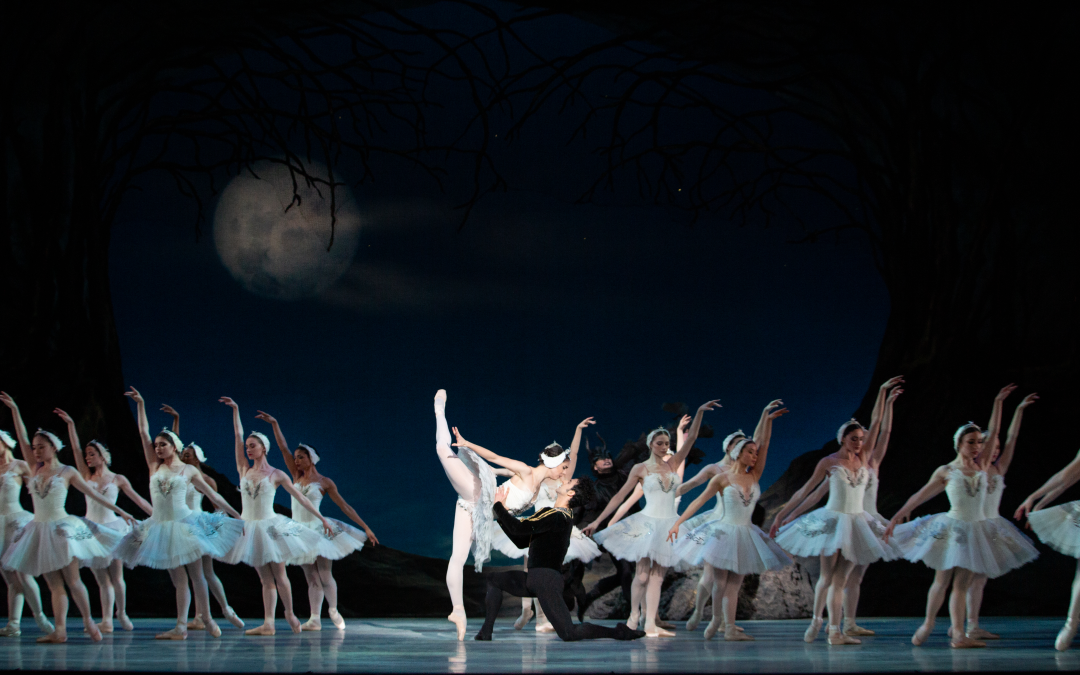By Kate Mattingly
One of the most famous tales of devoted fans is the story of ballet aficionados eating the pointe shoes of dancer Marie Taglioni in 1842. Taglioni attracted acclaim for her superhuman performances that merged strength and delicacy, and she used her pointe shoes to enhance her ethereal, otherworldly qualities. She passed in 1884, a decade before Swan Lake, choreographed by Marius Petipa and Lev Ivanov to music by Pyotr Tchaikovsky, had its premiere and revolutionized roles for women and choreography for the pointe shoe.
Ballet fans continue to flock to Swan Lake to see women transform into iconic characters––Odette, the white swan, and Odile, the black swan––and to savor their performances instead of the pointe shoes. From April 14 to 16, audiences in Norfolk have a chance to see Swan Lake performed by Philadelphia Ballet, with internationally acclaimed dancers in the role of Odette/Odile: Nayara Lopes, born in Brazil; Oksana Maslova, born in Ukraine; Dayesi Torriente, born in Cuba.
This version of Swan Lake, choreographed by Angel Corella, draws inspiration from the 1895 Petipa/Ivanov version and will be presented at Chrysler Hall as part of the Virginia Arts Festival. Corella is not only famous for his thoughtful leadership of Philadelphia Ballet––he was appointed artistic director in 2014––but also for his own performances of Swan Lake.
In 2005, when Corella was a principal dancer with American Ballet Theatre, he was filmed performing Swan Lake at The Kennedy Center with Gillian Murphy. The DVD has been called “the greatest performance ever of Swan Lake.” The technical feats of Corella and Murphy, combined with their expressive storytelling, are extraordinary. When asked about his choice of choreographing Swan Lake, Angel Corella recently told a reporter, “I think I danced Swan Lake with like 20 different companies around the world… I tried to gather all the different beautiful moments from the many different versions that I’ve done and put them together into this Swan Lake.”
One reason why this story continues to attract devoted fans and grow audiences for ballet is the dual role of Odette/Odile: one dancer performs radically different choreography. As Odette, she is demure and kind; as Odile she is seductive and fiery. She is both the hero and the villain of the story. Talking to the three women who will perform this role in Norfolk revealed the intricacies of the dancing and why people should see each of these dancers in this ballet.
Dayesi Torriente says the role is challenging “because it’s so iconic, and I always want it to be better than the last time I did it.” Dayesi, who remembers seeing Swan Lake performed in Cuba when she was a child, is invested in adding details and finding elements in the acting and choreography to make each performance more compelling and captivating.
For Oksana, who remembers seeing Swan Lake as “a 5- or 6-year-old” on a television program in Ukraine, says the challenge is in the technical demands, especially the choreography for the dancer’s arms. To transform into a swan, the ballerina must articulate each part of her arms to suggest wings. Oksana adds, “There are so many tiny muscles in each arm and to look like a swan is really hard!”
Nayara Lopes remembers seeing Gillian Murphy perform Swan Lake when Nayara was 17. She says the dancing is challenging because of the combination of technical demands plus the acting that role requires. “You have to be strong, and you have to be tasteful,” she says. The Odile role is famous for the 32 fouettés, or whipping turns on one leg, that occur in Act 3, and this difficult step occurs three-quarters of the way through the performance when the ballerina is, understandably, very tired.
These fouettés are also one of the most famous choreographic moments in the classical repertory: the whipping action of the ballerina’s leg suggests a snare trap that she is using to lure Prince Siegfried into pronouncing his love for her. The ballet step functions as both a virtuosic feat and a metaphor for reeling someone in. Typically, the audience bursts into applause when the ballerina finishes the fouettés, signaling appreciation for her strength and for driving the narrative towards its tragic ending.
Nayara says she “looks up to” Oksana and Dayesi who have both performed the role to critical acclaim. Oksana has been praised for her performances as Odette/Odile: she “seems to emanate emotion from every limb. Maslova’s flexibility and extension are always impressive, but today her arms seemed to transform into fluttering wings.” Dayesi has been complimented for her strong and beautiful dancing in the dual role of Odette/Odile.
In February, when we met on Zoom for an interview about the performances, the three women laughed and listened to one another in ways that suggested friends more than work colleagues. The conversation was full of insights about similarities and differences in their careers, all shared with a refreshing sense of curiosity and support for one another. This camaraderie contrasts with ballet settings that are known for competition and rivalries. For instance, Dayesi is known for taking time to do her nails, because this enhances her beautiful hands and port de bras, and said, “I do my nails myself. I don’t go to a salon.” Nayara laughed, “I like having beautiful nails too, but I need to get them done by someone else!”
When asked what makes Philadelphia Ballet different from other ballet companies, each dancer noted how the people in the organization make it unique.
Oksana, who has danced at the Odessa National Opera House and with Grand Rapids Ballet, says that she was attracted to Philadelphia Ballet because “I think it’s about the people, because people in a company influence what repertory a company does, and I like being in a company that has dancers from everywhere.” Nayara, who danced with National Ballet of Canada and the Dance Theatre of Harlem prior to Philadelphia Ballet, echoes this sentiment saying, “It has been really nice to see everyone understand the value of diversity.”
Audiences in Philadelphia are lucky to have a company that often presents performances with multiple casts, and casts that are very different. Dayesi, who danced with the National Ballet of Cuba prior to coming to Philadelphia, says that she feels supported in exploring different facets of a role: “We all have our personalities and our own ways of dancing certain parts. It is not as if there is only way to do a role.”
While this may seem obvious, ballet companies have, historically, struggled with adapting to societal changes and some directors have held onto rigid notions of who can be a ballet dancer and what kind of performances should be presented. This kind of narrowmindedness has led some people to avoid ballet performances and to regard the art form as antiquated. Angel Corella is changing this mindset by presenting Swan Lake as a story about desire and commitment that connects with many people’s lived experiences, and showcasing beautiful ballerinas from around the world in its leading role.
Each of these women has invested deeply in ballet and navigated challenges in order to perform the role of Odette/Odile. Nayara, who shares a favorite quote from Albert Einstein in her biography on Philadelphia Ballet’s website, says “I came to this country when I was 16 years old. I had no money, like $200 in my pocket, and I stayed in the house of a friend that my mom knew. Since then, my path to this role has been a journey, and I met so many people who helped me, but I never had someone with me, never had a family. In some ways I feel like a loner. People have helped me and have taught me how you have to live with curiosity. You have to put yourself out there if you want to enjoy life. And now I feel like I finally have a company and really good friends. I’m still alone, but with a good foundation and good all around me.” The Einstein quote is, “Be a loner. That gives you time to wonder, to search for the truth. Have holy curiosity. Make your life worth living.”
For Oksana, these performances are especially meaningful due to the war in Ukraine. She says, “Honestly, it’s hard to wake up every day and push myself to leave my home and not be depressed. There is so much tragedy. Every day, I feel pain most of the time. I remember performing the white swan after the war started and I would cry onstage because it fits the role and fits what I was feeling. With the Black Swan, I keep thinking about the courage of the soldiers and what people are going through. The only reason why I’m dancing now, and have not given up, is because I want people to see my name and see that it says I’m from Ukraine, from a little town, Nikopol. This is very important for me. It’s my little victory during a really difficult time.”
Oksana’s words speak to the power of dancing, the power of communicating through our bodies and movement, that can connect humans across borders and cultures. Audiences today may not be as obsessed as the fans who ate Taglioni’s pointe shoes, but these women, Dayesi, Nayara, and Oksana, ignite wonder and awe. They are deeply invested, curious, and knowledgeable about the world. When they are on stage, ballet’s future is bright.
WANT TO GO?
Swan Lake
Philadelphia Ballet
April 14 to 16
Chrysler Hall




